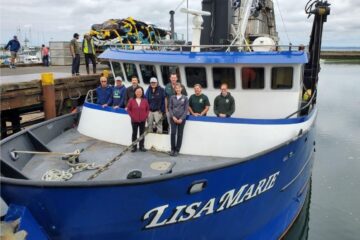SeafoodNews_FishingStocksUWStudy
SEAFOOD.COM NEWS [seafoodnews.com] April 29, 2011
A major new study by Dr. Trevor Branch and colleagues at the University of Washington shows that estimates of collapsed and overfished stocks may be exaggerated. Branch, writing in the Journal of Conservation Biology, argues that actual scientific data on biomass shows that a much smaller proportion of fish stocks are collapsed or overfished, than studies that rely on catch statistics.
The oft repeated claim that 30% of global fisheries are collapsed, and 70% are either overexploited or collapsed, is generally based on extrapolating catch data. Branch shows that when the actual biomass of these stocks is measured, the picture looks different. He finds that using biomass measurements, about 12% of global fisheries are collapsed (meaning that the stock is less than 10% of its unexploited state), and 26% are either overexploited or collapsed, meaning another 14% have biomass levels less than 50% of that necessary to produce a long term maximum sustainable yield.
Why is the conventional wisdom about fish stocks wrong? Because measurements of catches only do not take into account political, market, and taxonomic changes that make the data less reliable.
According to the Univ. of Washington statement on the study, fish and marine species are among the most threatened wildlife on earth, due partly to over exploitation by fishing fleets. Yet there are differences in assessing trends in worldwide fishing stocks which, researchers writing in Conservation Biology argue, stem from inappropriate use of time trends in catches.
“Estimates of fishery status based on catches suggest that around 30% of fisheries are collapsed and 70% are overexploited or collapsed,” said lead author Dr Trevor Branch from the University of Washington in Seattle. “Our assessment shows that the data are seriously biased, and that instead we should be looking at biomass data.”
Biomass data from scientific stock assessments indicated a much smaller proportion in these categories (12% collapsed, 26% overexploited or collapsed), and that status trends are stable. Dr Branch’s analysis suggests that in most regions fisheries management has led to stabilization, and even recovery, of fished populations.
“Species which are targeted by fishing fleets are divided into stocks, a division of species into units based on political boundaries, genetic divergence, and biological characteristics,” said Branch. “The depletion of these stocks has important implications for ecosystem biodiversity; however methods of measuring depletion vary greatly.”
Dr Branch’s team considered stocks being “collapsed” or “overexploited” on the basis of catch and biomass data. Collapse is defined as biomass of less than 10% of unfished levels while over exploitation is defined by the governments of the United States and Australia as biomass below 50% of biomass that would produce maximum sustained catches. These reference points are widely used in fisheries management, either as management targets or as limits not to be exceeded.
“Our study found the status of stocks worldwide based on catch trends to be almost identical to what would be expected if catches were randomly generated with no trend at all,” said Branch, “and that most classifications of collapse on the basis of catch data are not true collapses but are due to taxonomic reclassification, regulatory changes in fisheries, and market changes.”
Dr Branch’s team argue that where available, biomass data can be used to ground truth catch trends, revealing that catch data greatly overestimates the percentage of stocks collapsed and overexploited.
Although the team’s biomass data was primarily from industrial fisheries in developed countries, the status of these stocks estimated from catch data is similar to the status of stocks in the rest of the world estimated from catch data.
“Instead of focusing on what we take out of the oceans (catches), we should be examining the actual state of the ecosystem (biomass data),” concludes Branch. “Catch data produce seriously biased estimates of what is going on in ocean ecosystems, and we need more effort expended on scientific surveys and stock assessments, especially in areas that are currently poorly assessed.”
Full Citation: Branch TA, Jensen OP, Ricard D, Ye Y, Hilborn R, “Contrasting global trends in marine fishery status obtained from catches and from stock assessments”, Conservation Biology, April 2011, DOI
John Sackton, Editor And Publisher
Seafood.com News 1-781-861-1441
Email comments to jsackton@seafood.com


